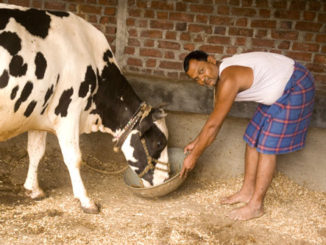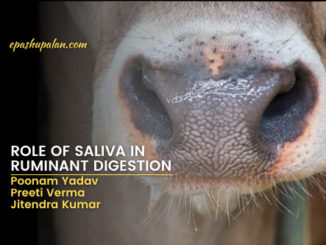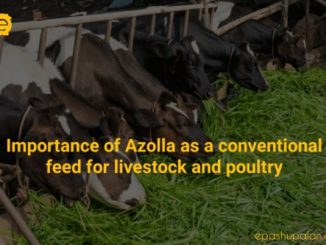Introduction
Nutritional status of animals reflects the productive and reproductive functions of animals and in tropical country like India mineral imbalances or deficiencies are very common. In India livestock are maintained on grazing with little or no supplementation of mineral mixture, except common salt and locally available feeds and fodder vary in mineral content making mineral deficiency an area specific problem.
The term “bioavailability” has been defined as the degree to which an ingested nutrient in a particular source is absorbed in a form that the nutrient is “available” at the tissue level rather than just at the dietary level. Bioavailability should not be considered as an inherent property or characteristic of the material being assayed, but, rather, an experimentally determined estimate which reflects the absorption and utilization under conditions of the test
Bioavailability of one mineral is also influenced by the concentration of other minerals in the diet. For example, high levels of sulfur or molybdenum interfere with copper absorption. While analysis of the copper concentration in the diet may reflect a sufficient amount, because of this antagonism, an animal may actually be copper deficient.
Mineral content in green vegetation depends on physical and chemical properties of soil, soil erosion, cropping pattern, fertilizers and chemicals application, species and genetic differences among plants, stage of growth, presence of other minerals etc. Availability of minerals also decreases with maturity of fodder. Changing availability of feed and fodder resources and deterioration condition of grazing lands, evaluation of the mineral content of feeds and fodders is required for assessing the deficiency/ excess and development of suitable area specific supplementation.
Absorption of Minerals
Before absorption by the absorbing enterocytes in the gastrointestinal tract can take place, the minerals must become available in ionic form (as cations and anions), which is suitable for uptake and transport.
In principal, the trans-epithelial transport consists of both, an active trans- cellular component which can be regulated and/or a passive para-cellular component which depends on chemical and electrical gradients existing across the intestinal wall.
Passive transport through the gut wall, mediated by hormonal control that is primarily based on their concentration in the extra cellular fluid. Before absorption by the absorbing enterocytes from the gastrointestinal tract, the minerals must become available in ionic form (as cations and anions), which is suitable for uptake and transport. Although interactions among various minerals occur during this absorption (e.g. calcium and phosphorus; calcium and zinc; copper and zinc; copper, molybdenum and sulphur)
Bioavailability
The percentage of mineral absorbed as related to the amount fed to animal. No nutrient is absorbed and utilized to the full extent that it is fed. When 2.5 lbs. of protein fed per day. Digestibility is only 65 percent, actually received is about 1.625 lbs. The same is true with minerals.
As the genetic progress of the herd improves
- forage mineral bioavailability
- mineral interactions
- stage of production
- breed
Bioavailability of one mineral is influenced by the concentration of other minerals in the diet. Ex: high levels of sulphur or molybdenum interfere with copper absorption
Practical determination of animal’s mineral status is often very difficult. Generally serum, hair and milk are used to analyse mineral status of a animal. Serum analysis is a poor indication of mineral status for many of the minerals. Same is true with hair and milk, different minerals have different concentration presence in different biological samples. In some cases liver biopsy is also used to determine the mineral status of animal more accurately.
Methods for evaluating the bioavailability of minerals
- In vivo techniques, which are expensive
- In vitro techniques, which are relatively economical
- Semi In Vivo Techniques, cell cultures and tissues
- Using chamber, adopted from rumen absorption studies by Schroder et al., in 1995. This technique was closely linked with those biological parameters and it was inexpensive too. This lead to tabulated values that can easily be applied in practice, or fit in an existing evaluation system.
In vivo experiments
Here animal performance (average daily gain, feed intake, feed conversion ratio, reproduction characteristics); Digestion/absorption coefficients; Concentrations in several tissues (bone and organs, such as liver, kidneys, muscle, spleen) are considered and monitoring is done for mineral status analysis.
Morphological characteristics in several tissues are seen and blood parameters (concentrations of the minerals, enzyme activities, hormones) are analysed
Concentrations in secretory fluids (bile, pancreatic fluid) and concentrations in urine are also considered to find out recycling or excretion.
In vitro techniques
This approach has not resulted in satisfactory results as it is very difficult to simulate the gastric and intestinal conditions properly
Terms used to express the bioavailability of minerals
- Digestibility/absorbability – Gastrointestinal tract (feed – faeces)
- (Bio) availability or bio efficacy- retained in the body [feed – (faeces + urine)] (Partridge, 1980)
Factors affecting mineral content of forages
- Soil: soil mineral concentration is generally directly proportional to forage mineral content. Young and alkaline geological formations more abundant in most trace elements than the older, more acid, coarse, sandy formations.
- Plant species: Different species vary in their mineral composition, like some accumulate some specific minerals. Legumes are richer in a number of minerals than are grasses. Micro mineral concentration of forages growing across seasons is generally less variable than macro mineral concentrations.
- Stage of maturity: Immature plants are generally rich source of variety of minerals. As plants mature, mineral content declines due to the natural dilution processes and translocation of nutrients to the root system
- Yield
- Pasture management
- Climate: Leaching and weathering of soils in tropical regions, under conditions of heavy rainfall and high temperature, accentuate mineral deficiencies.
Mineral content in soil keeps on changing due to pressure on land for maximum crop production, fertilizer application and natural calamities, which may alter the nutrient contents in feeds and fodders thereby affecting the mineral status of animals. Knowledge of the level of minerals in feeds and fodders of a particular area is essential for balancing dietary mineral requirements and formulating the area specific mineral mixture, which will be practical as well as cost effective.
Bioavailability of calcium
Ca is present in bone tissue as the hydroxyapatite form of calcium phosphate (99%) and Soft tissues of the body (1%)
Bioavailability depend on vitamin D concentration, Ca/P-ratio, phytate or oxalate complexes, anion/cation-ratio, dietary magnesium and aluminium, particle size, etc . Vit D is known to increase absorption od Ca in GIT thus bioavailability too.
Sources of Ca are calcium carbonate, limestone, oyster shells, calcium phosphates, calcium sulphate and bone and meat meals. Also particle size of calcium sources has a distinct influence on the rate of solubility of the calcium. Smaller particle have better absorption rate.
Bioavailability of magnesium
Mg plays structural role in the skeleton associated with hydroxyapatite crystals (60 to 70% of total magnesium of the body). Also play functional roles such as nerve function and muscular contraction. Mg is component of several enzymes implicated in the metabolism of carbohydrates, lipids and proteins.
In ruminants, magnesium absorption occurs predominantly in the reticulo- rumen section of the gut. Usual recommendation is to provide dairy cows with additional 25 g magnesium a day for better production performance.
Bioavailability of sodium
Sodium (and chlorine) maintain osmotic pressure, regulate acid-base equilibrium and control water metabolism in the body. Addition of salt to a feed replete with sodium can lower feed intake. According to the type of diet, practical diets require less or more supplementary sodium, although for microbial growth it does not play any direct role except osmotic pressure. Till now, No publications suitable for the study of sodium bioavailability of ruminants
Common salt (NaCl) is mostly used for sodium supplementation, although for regulating acid-base balance and to optimise chlorine levels sodium bicarbonate is used. Other sources of sodium are sodium-containing phosphates and sodium sulphate.
Bioavailability of phosphorus
P is important component of the skeleton (80%). Nucleotides, such as ATP, nucleic acids, phospholipids, and many other phosphorylated compounds(20%) also contain P. Absorption takes place predominantly in the small intestine.
Large differences in absorption and utilisation of phosphorus can be found, depending on the nutritional status of the animal
Factors affecting bioavailability of P are intake level, age of the animal, levels of dietary mineral compounds, e.g., calcium, phytic acid and phytase, magnesium and intestinal pH.
Phosphate sources include dicalcium phosphate (anhydrous or hydrated), monocalcium phosphate, or mono-dicalcium phosphate • Lactating animals have higher levels of addition of phosphorus in their diets compared with pregnant animals
Bioavailability of cobalt
Co is component of vitamin B12 . Vitamin B12, also known as cobalamin contains about 4.5% cobalt . Cobalt deficiency leads to “wasting diseases” as a result of inadequate synthesis of vitamin B12 from dietary cobalt.
Deficiency is common in particularly in grazing animals
Co is dstributed throughout the body with high concentrations in liver, bone and kidney. It is supplemented as cobalt sulphate.
Bioavailability of copper
It is essential component of several metallo enzymes. Copper deficiency is a serious problem for grazing ruminants in many countries of the world. Due to both low concentrations of the element in forage as well as elevated amounts of molybdenum and sulphur, which interfere with copper utilisation. Cu is supplemented in the range of 10 to 30 mg/kg.
Bioavailability of iron
Fe plays key role in many biochemical reactions. All of the iron in the animal’s body is organic in nature and only a very small percentage is found as free inorganic ions.
Haemoglobin (blood) contains about 60% iron and Myoglobin 3% .
Iron content of the body varies with species, age, sex, nutrition and state of health and is controlled by adjustment in absorption rate.
Ruminant diets are usually not supplemented with iron, because roughage contains already a high amount of iron due to contamination with soil particles. No publications suitable for the study of iron bioavailability of ruminants. Although there is a theory of mucosal block according to which, once body Fe requirement are fulfilled, intestinal mucosal block occurs which prevent further absorption on Fe from GIT.
Bioavailability of iodine
Tissues concentration for I is 0.1 μg/g body weight. It is integral part of the thyroid hormones thyroxin (tetraiodothyronine) (T4) and triiodothyronine (T3). Plants, water or other animal feedstuffs have highly variable concentrations of iodine.
Differences in species and strains, climatic and seasonal conditions, the type of soil, the fertiliser treatment or possible interactions affect bioavailabilityof I. Thyroid gland capture up to 90 % of the iodine by a Na/K-dependent ATP-ase. Predominant sources are calcium iodate and ethyl diamine hydro iodide (EDDI) or organic forms of iodine Potassium or sodium iodide are less stable sources
Bioavailability of manganese – Important function in blood clotting and lipid and carbohydrate metabolism . Deficiency lowers the activity of the manganese superoxide dismutases. Abnormal male and female reproductive functions are observed in Mn deficient animals.
Absorption is affected by manganese source, dietary antagonists (fibre, phytate, high levels of calcium and phosphorus, iron, magnesium) and depends on the concentration in the diet.
Most diets for ruminants are likely to be deficient in manganese.
Mn is supplemented as manganese sulphate, manganese oxide or various organic forms
Bioavailability of molybdenum
Mo is considered as a toxic element because of its interference with the copper metabolism in ruminants. It is a component of the enzymes xanthine oxidase, aldehyde oxidase and sulphite oxidase. Xanthine oxidase and aldehyde oxidase play role in electron transport chain and Aldehyde oxidase in niacin metabolism
There are no evidence of characteristic symptoms of molybdenum deficiency in ruminants. Supplementation of ruminant diets is not usual for molybdenum but added to counteract toxicity risk due to high levels of copper supply.
Bioavailability of selenium
Toxic element causing the lost of hair, nails and hooves.
Chronic selenium toxicity have been related to consuming selenium- accumulating plant. Acute toxicity needs a much higher selenium level in the diet
Se is main constituent of glutathione peroxidase which, associated with vitaminE plays a role of “cellular scavenger” protecting cellular membranes from oxidative effects (peroxides and free radicals)
Se concentration depends on the soil concentration of selenium. Seeds and by-products have generally higher selenium content than forages.
Animal by-products including fish meals, but with the exception of milk products have high concentration of selenium. Se is supplemented as sodium selenite.
Bioavailability of zinc
Activates several enzymes and is a component of metalloenzymes. It is most abundant intracellular trace mineral in animals and primarily absorbed from the small intestine. Animal diets require supplementation with zinc because of either low dietary levels or the presence of dietary factors that decrease bioavailability of the mineral (e.g. phytic acid).
Supplemented in diets for all species of livestock in the range of 30 to 250 mg/kg to cover their requirements . Zn is supplemented as zinc sulphate (ZnSO4·xH2O) or as zinc oxide
Factors affecting Trace Mineral Bioavailability in Ruminants
- Dietary factors that affect bioavailability of minerals differ greatly between ruminants and non-ruminants.
- In ruminants, microbial digestion in the rumen and reticulum precedes mammalian digestion in the abomasum and small intestine.
- Ruminant diets are usually high in fibre, and considerable digestion of fibre occurs via microbial fermentation in the rumen.
- The pH in the rumen environment is only slightly acidic (6.0–6.8), and in the rumen, many trace minerals exist largely in an insoluble form
Conclusions
- Locally available feeds and fodder are varying in mineral content and mineral deficiency is an area specific problem.
- Mineral status of locally available feedstuffs is essential.
- Mineral content dependent on the soil, which nourishes the plants
- Availability decreases with maturity of fodder
- Agro-climatic conditions – mineral content in green vegetation depends on physical and chemical properties of soil, soil erosion, cropping pattern, fertilizers and chemicals application, species and genetic differences among plants, stage of growth, presence of other minerals etc
- Understanding the bioavailability of various mineral sources effective mineral mixture supplementation can be provided






Be the first to comment